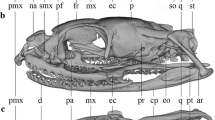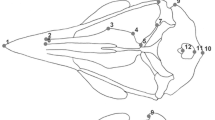Summary
Data were gathered on body weight, body length, relative maximum bite force and relative maximum gape for six sympatric species of neotropical cats (Felidae) to see if constant size ratios occur between adjacent species or if the minimum ratio in a series is greater than expected by chance. Although clearly likely to be correlated, these four parameters were thought to have potential for some independent variation and independent influence on prey capture abilities. None of the four sets of ratios was statistically distinguishable from random when all six species were included in the analysis; however, the ratios for relative maximum gape among just the four largest species were significantly more even and the minimum ratio significantly greater than expected by chance among four species. This constancy occurs because of departures of jaw lengths from what would be expected by the average allometric relationship between this parameter and total body size. Competitive character displacement is a possible explanation for the constant ratios in maximum gape of the larger species, but it is not the only possibility.
Similar content being viewed by others
References
Barton DE, David FN (1956) Some notes on ordered random intervals. J Royal Stat Soc, B, 18:79–94
Case TJ (1982) Coevolution in resource-limited competition communities. Theor Pop Biol 21:69–91
Emerson SB, Radinsky L (1980) Functional analysis of sabertooth cranial morphology. Paleobiology 6:295–312
goodnight JH, Sall JP, Sarle WS (1982) GLM. In: Ray AA (ed). SAS user's guide: statistics. SAS Institute, Cary NC, p 139–200
Guggisberg CAW (1975) Wild cats of the world. Taplinger, New York
Hairston NG, Smith FE, Slobodkin LB (1960) Community structure, population control, and competition. Am Nat 94:421–425
Hall ER (1981) The mammals of North America. Wiley, New York
Honacki JH, Kinman KE, Koeppl JW (1982) Mammal species of the world. Allen Press, Lawrence, Kansas
Husson AM (1978) The mammals of Suriname. Brill, Leiden
Hutchinson GE (1959) Homage to Santa Rosalia or Why are there so many kinds of animals? Am Nat 93:145–159
Jaksié FM (1981) Abuse and misuse of the term “guild” in ecological studies. Oikos 37:397–400
Kiltie RA (1982) Bite force as a basis for niche differentiation between rain forest peccaries (Tayassu tajacu and T. pecari). Biotropica 14:188–195
Kiltie RA, Terborgh J (1983) Observations on the behavior of rain forest peccaries in Perú: Why do white-lipped peccaries form herds? Z Tierpsychol 62:241–255
Kurtén B (1973a) Geographic variation in size in the puma (Felis concolor). Comment Biol Soc Sci Fennica 63:1–8
Kurtén B (1973b) Pleistocene jaguars in North America. Comment Biol Soc Sci Fennica 62:1–23
Lande R (1980) Sexual dimorphism, sexual selection, and adaptation in polygenic characters. Evolution 34:292–307
Leopold AS (1959) The wildlife of Mexico. Univ California Press, Berkeley
Leyhausen P (1963) Über südamerikanische Pardelkatzen. Z Tierpsychol 20:627–640
Leyhausen P (1979) Cat behavior. Garland STPM Press, New York
Løvtrup S (1977) Derek Roff and the evolution of body size: a rejoinder. Evol Theory 3:155–157
Løvtrup S, Rahemtulla F, Hoglund N-G (1974) Fisher's axiom and the body size of animals. Zool Scripta 3:53–58
May RM, MacArthur RH (1972) Niche overlap as a function of environmental variability. Proc US Nat Acad Sci 69:1109–1113
McNab BK (1971) On the ecological significance of Bergmann's rule. Ecology 52:845–954
Mendez E (1970) Los principales mamíferos silvestres de Panamá. Edicion Privada, Panama City
Perry R (1970) The world of the jaguar. David and Charles, Newton Abbott
Radinsky LB (1981) Evolution of skull spape in carnivores 1. Representative modern carnivores. Biol J Linn Soc 15:369–388
Ricker WE (1973) Linear regressions in fishery research. J Fish Res Bd Can 30:409–434
Roff D (1977) Does body size evolve by quantum steps? Evol Theory 3:149–153
Root RB (1967) The niche exploitation pattern of the blue-gray gnatcatcher. Ecol Monogr 37:317–350
Rosenzweig ML (1966) Community structure in sympatric Carnivora. J Mammal 47:602–612
Roth VL (1979) Can quantum leaps in body size be recognized among mammalian species? Paleobiology 5:318–336
Roth VL (1981) Constancy in the size ratios of sympatric species. Am Nat 118:394–404
Roughgarden J (1979) Theory of population genetics and evolutionary ecology. Macmillan, New York
Roughgarden J (1983) Coevolution between competitors. In: Futuyma DJ, Slatkin MS (eds). Coevolution. Sinauer, Sunderland MA, p 383–403
Schaller GB, Vasconcelos JMC (1978) Jaguar predation oncapybara. Z Saugetierk 43:297–307
Schmidt-Nielson K (1979) Animal Physiology. Cambridge Univ Press, Cambridge
Schoener TW (1965) The evolution of bill size differences among sympatric congeneric species of birds. Evolution 19:189–213
Schoener TW (1967) The ecological significance of dimorphism in size in the lizard Anolis conspersus. Science 155:474–477
Schoener TW (1977) Competition and the niche. In: Gans G, Tinkle DW (eds). Biology of the Reptilia (Vol 7). Academic, London, p 35–136
Schoener TW (1982) The controversy over interspecific competition. Am Sci 70:586–595
Schoener TW (1983) Field experiments on interspecific competition. Am Nat 122:240–285
Schoener TW (in press) Size differences among sympatric, birdeating hawks: a worldwide survey. In: Strong D, Simberloff D, Abele L (eds). Ecological communities: conceptual issues and the evidence. Princeton Univ Press, Princeton
Seidensticker J, Wiles WV, Messick JP (1973) Mountain lion social organization in the Idaho Primitive Area. Wildl Monogr 35:1–60
Selander RK (1972) Sexual selection and dimorphism in birds. In: Campbell BG (ed). Sexual selection and the descent of man 1987–1971. Aldine, Chicago, p 180–230
Simberloff D (1983) Sizes of coexisting species. In: Futuyma DJ, Slatkin MS (eds). Coevolution. Sinauer, Sunderland MA, p 404–430
Simberloff D, Boecklen W (1981) Santa Rosalia reconsidered: size ratios and competition. Evolution 35:1206–1228
Slatkin M (1980) Ecological character displacement. Ecology 61:163–177
Slatkin M (1983) Models of coevolution: their use and abuse. In: Nitecki MH (ed). Coevolution. Univ Chicago Press, Chicago, p 339–370
Sokal RR, Rohlf FJ (1969) Biometry. Freeman, San Francisco
Turelli M (1977) Random environments and stochastic calculus. Theor Pop Biol 12:140–178
Turelli M (1978) A reexamination of stability in randomly varying versus deterministic environments with comments on the stochastic theory of limiting similarity. Theor Pop Biol 13:244–267
Turnbull WD (1970) Mammalian masticatory apparatus. Fieldiana: Geology 18:149–339
Wilson DS (1975) The adequacy of body size as a niche difference. Am Nat 109:769–784
Young SP, Goldman EA (1946) The puma. Amer Wildl Inst (reprinted by Dover, New York, 1964)
Author information
Authors and Affiliations
Rights and permissions
About this article
Cite this article
Kiltie, R.A. Size ratios among sympatric neotropical cats. Oecologia 61, 411–416 (1984). https://doi.org/10.1007/BF00379644
Received:
Issue Date:
DOI: https://doi.org/10.1007/BF00379644




